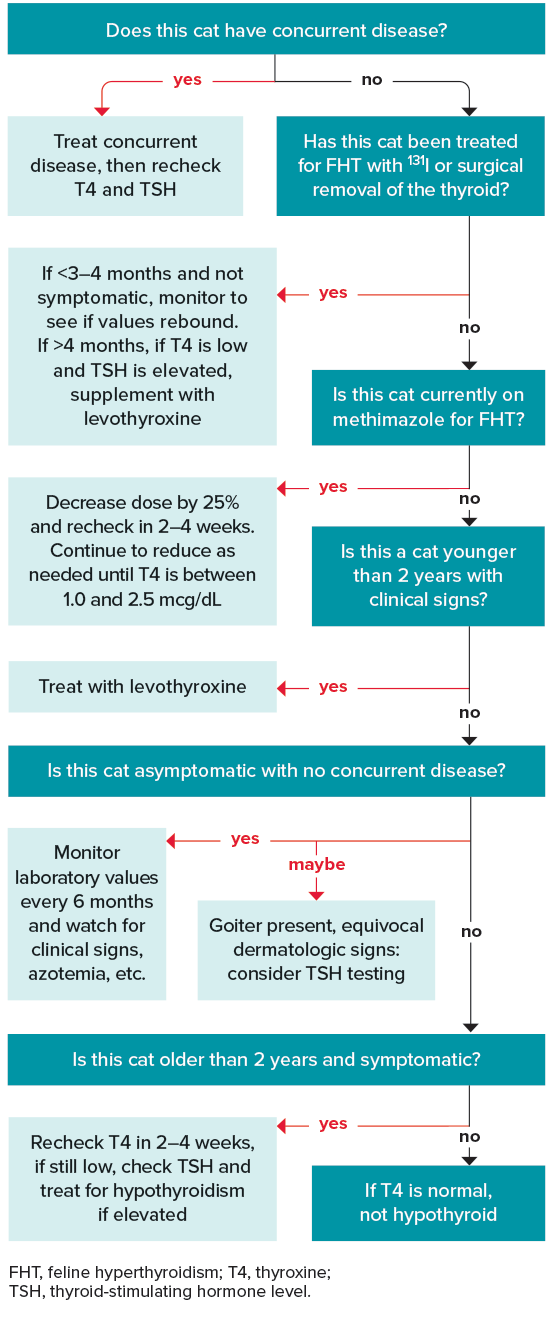Feline Hypothyroidism
Although naturally occurring hypothyroidism in cats occurs rarely compared with its incidence in dogs,79 it is occasionally reported in this species. A single low T4 level should be interpreted in light of the entire clinical picture because nonthyroidal illness can lead to reductions of serum T4 levels. The magnitude of serum T4 suppression is proportionate to the severity of the underlying disease. Final interpretation of thyroid function should be made when any nonthyroidal illness is stabilized, as well as in relation to the cat’s clinical presentation.
Clinical signs of feline hypothyroidism are shown in Table 11. Congenital hypothyroidism is usually identified in cats younger than 1 yr of age and most frequently in kittens younger than 8 mo. Affected kittens are usually stocky, with shorter limbs and a broader-than-usual head and neck. Lethargy, constipation, retained deciduous teeth, abnormal hair coat, and thickened gingiva are common findings.76
Diagnosis of hypothyroidism requires demonstration of a low serum T4 (<0.8 mcg/dL) and elevated TSH concentrations. Demonstration of low serum fT4 levels may also suggest hypothyroidism. A commercially available feline-specific TSH test was recently released; however, the historically used canine TSH test will also be elevated in cats with hypothyroidism.68 In contrast to hypothyroidism in dogs, cats with naturally occurring hypothyroidism are more likely to be azotemic.80 Figure 1 shows a diagnostic and treatment algorithm for deciding if a low T4 indicates a patient has feline hypothyroidism.
Treatment of hypothyroidism in cats is straightforward and similar to treatment in dogs. Levothyroxine sodium is recommended, with an initial dose range of 0.05–0.1 mg daily. The dosage is adjusted to target T4 levels between 1.0 and 3.0 mcg/dL; however, clinical signs may persist for 2–3 mo before responding to treatment.
Adult-onset hypothyroidism, although rare, may in fact be underdiagnosed in cats.81 Even if that proves to be true, it is still an extremely uncommon problem. Treatment should only be considered for cats with repeatable laboratory abnormalities and clinical signs consistent with hypothyroidism, such as lethargy, poor hair coat, and obesity. Confirmation of decreased serum T4 on more than one occasion, along with elevated TSH levels, is required to establish the diagnosis.
Iatrogenic hypothyroidism is caused by overdosing with antithyroid drugs such as methimazole, surgical removal of the thyroid glands, or 131I treatment. Once patients have been stabilized on methimazole, monitoring at least every 6 mo will ensure proper thyroid control and avoidance of hypothyroidism. When treating with 131I, consideration should be given to the T4 and TSH levels and the 131I should be dosed appropriately.82 Failing to recognize and address iatrogenic hypothyroidism can contribute to decreased renal function. 83 Maintaining T4 levels between 1.0 and 2.5 mcg/dL is ideal, and treatment should be initiated for patients with T4 values <1.0mcg/dL and an elevated TSH level. Additionally, cats with T4 levels within the reference range but an elevated TSH who develop a new or progressive azotemia may benefit from methimazole dose reduction or levothyroxine supplementation if surgically or 131I treated.
TABLE 11
Clinical Signs of Feline Hypothyroidism
Download PDF
| Congenital Disease |
|
| Iatrogenic or Adult-Onset Disease |
|
FIGURE 1
Decision Tree for Feline Hypothyroidism Diagnosis and Treatment
Download PDF









